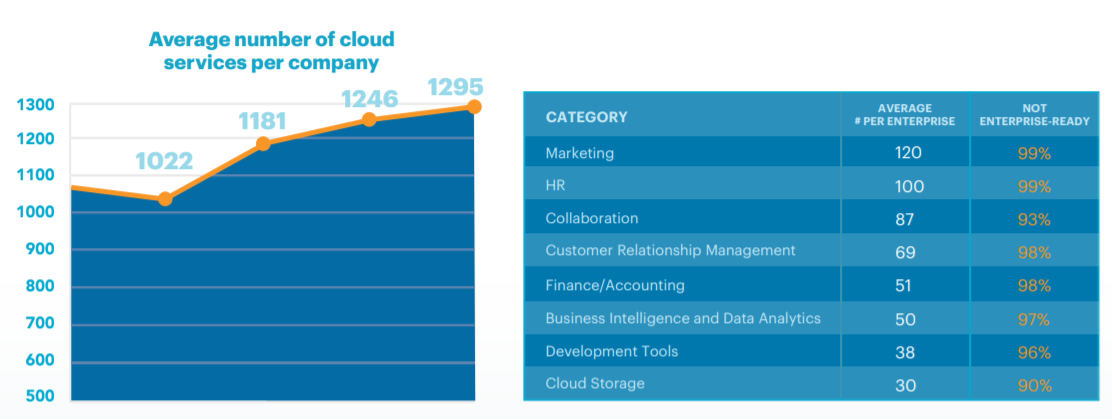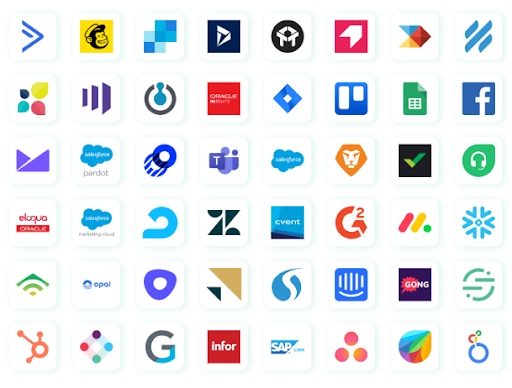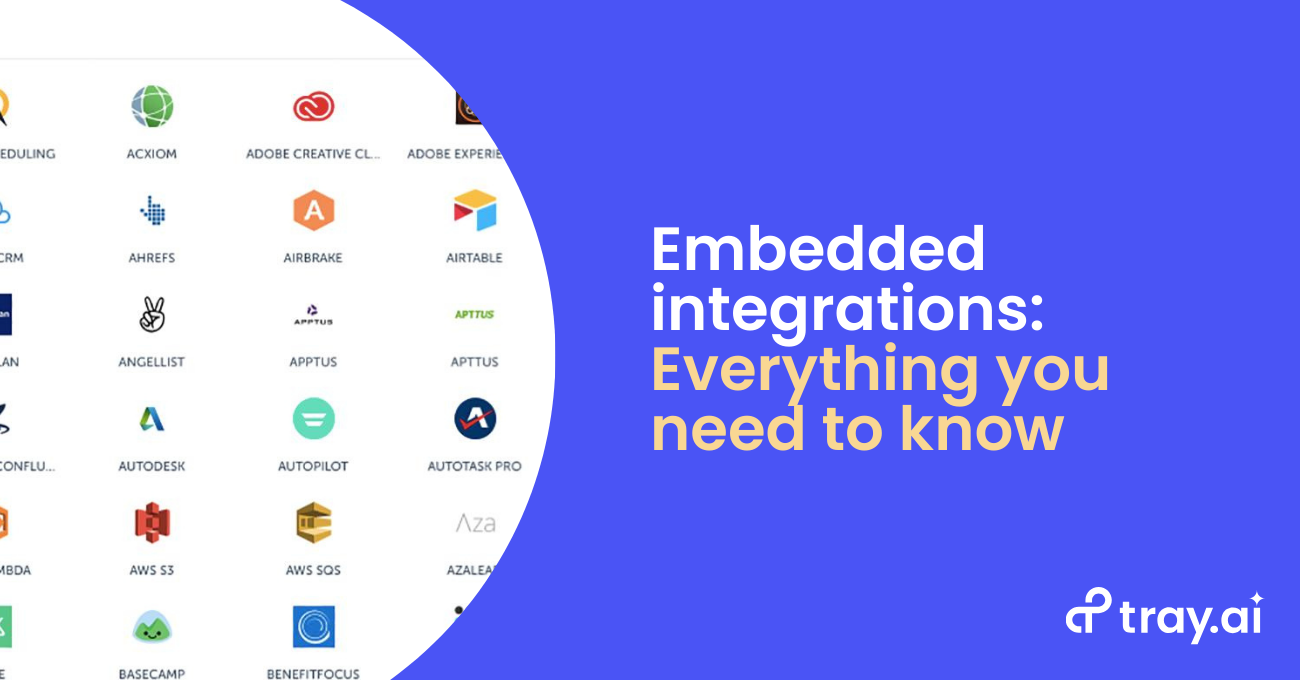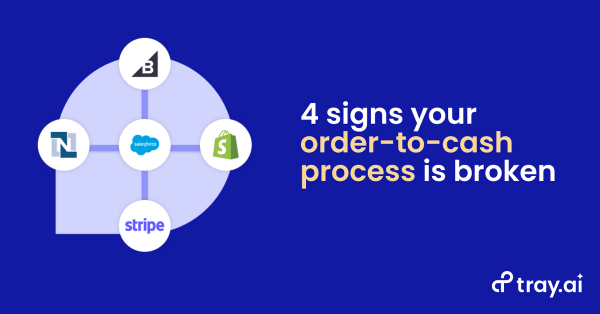Why product and technical leads need embedded integrations
Product and technical leads in modern software already know why customer integration requests are painful, expensive, and a clear and present competitive danger. While your team is supposed to be laser-focused on creating best-in-class products your customers fall in love with, your customers demand integrations that pull your team sideways. Get the full details in our e-book, The definitive guide to embedding integrations in your product.
Customers need integrations between your product and their tools, preferably delivered yesterday. Their sales teams need CRM integrations; their marketing teams need marketing campaign tool integrations; their support teams need helpdesk integrations...and quite a few other integrations for quite a few other tools.

Your customers use 1,000+ cloud services. None of them was built to integrate with your product. Image courtesy Netskope
The average enterprise uses more than 1,000 different cloud-based tools across sales, marketing, services, finance, HR, e-commerce, and every other function. Each tool is a point solution that may be good at what it does, but does not offer the integrations to your product that your customers need.
So your customers come to you. And they expect robust, API-level connectivity between your product and their tech stack. Fortunately for you and your team, you have already made the wise decision to avoid building integrations in-house. You already know that in-house integration builds are more than just a cost center; they’re an endless drag on innovation and engineering resources. In-house builds mean your must teams stop building better products to focus on spinning up a homegrown integration. Building integrations internally also means endless maintenance as your in-house integrations constantly break over time due to your customers’ tools eventually updating their APIs.
In fact, smart product and technical leaders know that a new, and much better, solution has emerged to address their customer integration challenges: Embedded integrations platforms. Embedded solutions offer product and technical teams the ability to incorporate the seamless connectivity of the best integration platforms on the market directly into their own products.
Product teams that utilize embedded integration solutions realize many valuable benefits. Using embedded integrations, teams can deliver integrations faster, which improves customer satisfaction and ultimately makes their products stickier. Teams that use embedded solutions can also empower their sales teams to win more deals from prospects that absolutely, positively need that one crucial integration, and need it now.
With embedded integrations, you can also be much smarter about resourcing by reducing your engineering burden by as much as 60% or more. A best-in-class embedded integrations solution gives product and engineering teams the opportunity to finally refocus on building better products, while sidestepping the painful and costly burden of building and maintaining internally.
What to look for in an embedded integration solution
Of course, not all integration solutions are equal. Here are just a few of the most important items to consider when shopping for an embedded integration solution:

Can your vendor integrate with a variety of tools, deliver integrations quickly, and offer robust security?
Speed: Look for a proven record of fast, efficient delivery
Look for vendors that not only have a proven track record of successfully accelerating their customers’ integration roadmaps, but also give your teams the power to deliver quickly. For example, some platforms offer a low-code front end to speed implementation, but the best solutions offer developer-grade low-code, which include custom logic operators, error handling, flat file processing, and support for a variety of custom operations, along with options to read, parse, and otherwise support code in a pinch.
Scalability: Look for modern architecture that won’t throttle resources
Believe it or not, there are still legacy integration vendors on the market offering platforms built on server-centric architecture. Such platforms rely on server-based “workers” to pass data across your customers’ integrations and their technical limitations will lead to degraded performance for your customers and potentially a bigger-than-expected bill for you during peak usage periods. As such, smart product teams look for solutions with the unlimited scalability offered by modern, serverless architecture.
Flexibility: Look for vendors with robust and varied connectivity capabilities
Your customers will probably end up needing more integrations than you think. So you will, of course, want a vendor with a substantial library of integrations for all the most popular and important business apps on the market. However, as you most likely already know from fielding complicated custom requests, your customers integration needs will often involve nonstandard configurations of their tools. Customers may, for instance, rely heavily on custom fields that will require custom data mapping to accommodate. They may also rely on their own homegrown tools that you can connect to only by way of custom REST or GraphQL endpoints, for which you’ll need alternative connectivity options, such as a connector SDK.
Security: Look for vendors with enterprise-grade certifications
You want your customers to have robust integrations done quickly via a best-in-breed embedded integration solution. You do not want them getting hacked because your integration platform’s security didn’t quite make the grade. Look for solutions that offer SOC 2 Type 2 certification, and are compliant with important data privacy regulations, such as GDPR (for Europe), CCPA (for California), and HIPAA (for healthcare).
Get the full story on embedded platform providers
To review, we have covered the challenges and benefits of embedded integrations, along with just a few of the specific points to consider when shopping for a solution. Rest assured, there are many other points to consider, such as maintenance, the user activation experience, and advantageously negotiating a fair contract. We cover everything you need to know in the full definitive guide to embedding integrations in your product, which also offers a complete checklist of technical features.




